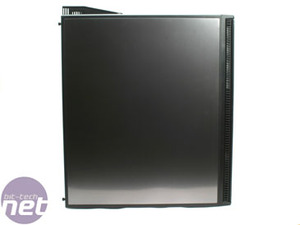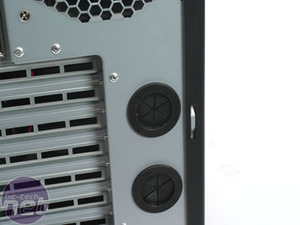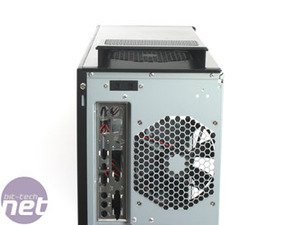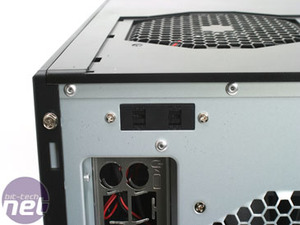
Testing
Every case we review and use has to run the gauntlet of tests that we lay before, testing how well the case handles heat while we evaluate how noisy is it when all case fans are running.For this heat test we installed our usual system;
CPU: Intel Pentium XE 955 (dual-core, 3.46GHz with Asus Silent Square heatsink)
Graphics Card: Sapphire Radeon X1600 XT
Motherboard: Asus P5WD2-E Premium
RAM: 2x 512MB Corsair XMS2 DDR2-667
Optical drive: Sony CD-RW Drive
Hard-Drive: 1x 240GB Hard drive
With that in place we run our gamut of stress tests, including a real-time HDR image-based lighting demo to push the GPU temperature up. It's a useful app if you ever fancy testing your own rig, though if you follow our recommendations then you'll never need to.
We began by measuring the idle system temperatures. Doing nothing, the internal case temperature was 27°C, while the CPU and GPU hovered at 43°C and 40°C respectively, all in an ambient of 23°C. Then, with the door closed and the fans set to high speed, we started stressing.
Our first two tests, designed to stress the RAM and CPU to a hundred per cent produced identical results. In each case the internal case temperature rose only a single degree to a pleasant 28°C while the CPU refused to go any higher than 58°.
Starting up the graphics stress test, with all the options pushed to maximum and the eye-candy on full, pulled the temperature up a fraction more. The internal case temperature settled at 28°C while the CPU and GPU peaked at 51°C and 54°C respectively. In other words the P182 performed just as admirably as it did before and the temperatures never got anywhere near even mildly dangerous levels.
While the stress tests were going on we also kept a close ear on the noise levels. With the fans running on low we didn't even realise the PC was running when it was on the desktop, that's how quiet it was. The triple-layered siding and rubber grommets that blanket the guts of this beast all perform their job well and ensure that barely a decibel escapes.
With the fans on high it's a slightly different story, but only slightly. The noise is definitely there when the PC is on the desktop, but it's easily drowned out by a bit of music or gaming and is barely noticeable anyway thanks to this utterly rattle-less design.
Conclusions
The Antec P182 is a truly magnificent case and there's very little not to love about it. Its design is cool and understated just like the much-loved original and the system functions near-silently thanks to a fastidious design, even when we deliberately try to hot things up under the hood.The best news is that the UK prices for the Antec P182 are very similar to the prices we found for the Antec P180 case, so there's no real reason not to upgrade to this improved design. Unfortunately, the gap in the American market is a little bigger and the US price for the P182 is a good $30 or $40 USD more than the P180.
Still, as a quality case it's not very expensive however you look at it. That's especially true with a case like this that performs so well in every area and still gives room for modders and Dremel addicts to customise it. Weak magnets? No handles? Who cares, this case is fantastic to look at, fiddle with and use every single day.
- Build Quality
- x
- x
- x
- x
- x
- x
- x
- x
- x
- x
- 10/10
- Ease of Use
- x
- x
- x
- x
- x
- x
- x
- x
- -
- -
- 8/10
- Features
- x
- x
- x
- x
- x
- x
- x
- x
- x
- x
- 10/10
- Performance
- x
- x
- x
- x
- x
- x
- x
- x
- x
- x
- 10/10
- Value
- x
- x
- x
- x
- x
- x
- x
- x
- x
- -
- 9/10
- Overall
- x
- x
- x
- x
- x
- x
- x
- x
- x
- x
- 10/10

Antec P182 Performance One

MSI MPG Velox 100R Chassis Review
October 14 2021 | 15:04














Want to comment? Please log in.